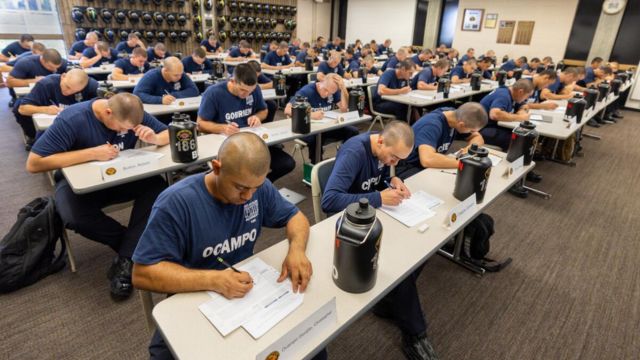MJP –
Edgar Roa’s mother was an immigrant who did not complete high school and reared him largely on welfare while the family moved to Southern California looking for cheap accommodation.
On the other hand, he is on track to receive a degree in a medical profession next spring from a school that charges an average of only $4,000 per year, and the median earnings are $126,318 after five years of graduation. With the help of his GI Bill benefits, a federal Pell Grant, and his high wages, Roa will be able to graduate from college debt-free and change his family’s financial situation.
He goes to Cal State Dominguez Hills, which is ranked as one of the best colleges in California for providing low-income students with excellent outcomes, according to a recent study. Dominguez Hills offered 28 different degree programs; 23 of these led to salaries high enough to pay for the program in one year or fewer. These included RNs making $122,899, business majors $61,910, and teacher education majors $43,988.

The research, which was issued on Thursday, offers clear statistics on the earnings of 2,695 degree and certificate program graduates from 324 California colleges and universities compared to a high school graduate after five years, which is important because there is growing skepticism about the value of higher education. Students may see the net cost of schooling and the rate of return on investment (ROI) in the statistics.
The Great California Divide: What Locals Believe Marks the Boundary Between North and South
Using federal and institutional data, the HEA Group—a research and consulting firm devoted to college access, value, and economic mobility—analyzed nearly 260,000 graduates who received federal financial aid. The report was commissioned by the Oakland-based nonprofit College Futures Foundation.
The president of the HEA Group, Michael Itzkowitz, stated, “We know that attending college can be one of the largest investments that anyone makes beyond getting a mortgage,” in discussing the findings. “So it’s critical that we have all of the data in front of us to ensure that we’re making the most informed choice possible.”
The head of the college foundation, Eloy Ortiz Oakley, stated that the growing skepticism towards higher education can be attributed to the lack of a “clear connection” between the financial investment required for education and the monetary return on investment.
“The No. 1 reason people go to college is to improve their economic mobility and the No. 1 reason they don’t go is the cost,” said Oakley. “This study offers a critical first step in helping state policymakers as well as institutional leaders identify what’s working but also what can work better to ensure strong financial outcomes for all who choose to pursue a postsecondary education.”
College names aren’t always more essential than majors.
According to the numbers, majors are more important than schools, and low-income students can get good graduate degrees from community colleges and campuses of California State University without going into debt.
Recruits for the Huntington Beach Fire Department go straight from classroom instruction to ladder training at Santa Ana College’s Basic Fire Academy.
California Law Enforcement Launches Historic Crackdown, 42 Arrested in White Supremacist Gang Bust
Eight campuses of the California State University system and one campus of the University of California, Merced are among the nine four-year universities that have high ROIs and have more than half of their student body on Pell Grants due to low incomes. These cities are home to California State University campuses: Dominguez Hills, Bakersfield, Fresno, Northridge, San Bernardino, Sacramento, and Stanislaus.
Graduates of Santa Ana College’s fire prevention program, for example, earn a median yearly salary of $114,446 after five years on the job, with net costs of just $2,994 for the two-year school. That’s double what a Stanford University alumnus made after deducting the cost of their four-year English language and literature degree ($56,399 minus $43,404) would have paid. Program expenditures after accounting for grant and scholarship funding are known as the net cost.
The report’s “earnings premium” illustrates the wage gap between high school dropouts and college grads. After five years of work, the average salary for a high school graduate is $26,073.
As the baby boomer generation retires and more people get affected by climate change, there is a rising demand for firemen, according to William Reardon, associate dean of the fire technology department at Santa Ana College. In 2023–24, there was a 16% increase to 12,300 students enrolled in fire technology and continuing education programs, compared to the previous year.
Additionally, he mentioned that the program had an admittance rate of 100%. You can get degrees that lead to careers as a firefighter, fire inspector, or fire administrator through this program.
The highest-earning degree at UCLA was in computer and information sciences, highlighting the significance of majors. With a median yearly salary of $218,770, these grads would earn enough to pay back their $62,548 in four years.
The analysis states that it would take 21 years to recuperate the cost of the degree from UCLA’s drama, theatrical arts and stagecraft program, and that graduates earn only $28,993 per year, which is scarcely more than the typical salary for high school grads.
Return on investment comparisons amongst institutions in the same field still take elite colleges into account. Earning a computer science degree from Stanford University will get you $247,797 a year, while earning a degree from Cal State Bakersfield will get you $83,688.
Among business majors, the five-year salary for a UC Berkeley grad is $145,003, which is over twice as much as the $64,019 earned by a Cal State Los Angeles grad.
But according to Oakley, most Californians, especially those with lower incomes, have a much harder time affording to attend “brand name” universities. According to the data, a significantly lower percentage of Stanford students (18.8%) receive Pell Grants compared to Berkeley (27.1%) and Cal State Los Angeles (66.2%).
“Based on the earnings data, we see there are a plethora of options for students to consider outside of the top named schools readily recognized in popular news publications … which can create potentially false narratives about value based on brand,” said Oakley. “‘Brand name’ institutions are not interested in serving California’s lowest-income learners in any great number.”
California’s Best Kept Secret: Affordable Stores Reselling Costco and Target Merchandise
Specifically, he urged the Los Angeles, Berkeley, and San Diego campuses of the University of California to “reach deeper into the pool of applicants” in order to increase the number of low-income students admitted.
“We should be rewarding institutions for how well they do to open up more access to the lowest-income Californians,” stated the governor. “That’s what our public universities were built for.”
Making a profit off of tuition
In general, graduates are able to return their college costs in five years or fewer through nearly 90% of programs in California.
Nevertheless, eleventy-two programs’ grads continued to earn lower wages than high school grads even after five years of employment. The majority of these schools offered certificate programs, and many of them catered to the beauty industry. For example, cosmetologists from Los Angeles Trade-Technical College made just $13,200 a year, which is half of what high school graduates make on average, proving that the industry was unwelcoming even to individuals with two-year associate degrees from community colleges.
Oakley advocated on school administrators to seek out methods to increase the return on underperforming programs, such as increasing the number of apprenticeships offered instead of more expensive college degrees and certificates.
“It’s critical that students not only investigate the institution that they’re applying to, but also the field of study that they’re looking to consider,” said Itzkowitz.
Programs that pay well for college
Science, technology, engineering, and healthcare produced the greatest ROI. Most RNs make six figures after five years in the sector, and the field is growing rapidly. RN programs typically last two years at a community college. Traveling nurses can earn $3,000 per week or more on 13-week contracts, because to the persistent nursing shortage.
At Huntington Beach’s Santa Ana College Basic Fire Academy, aspiring firefighters take a test before beginning their training on the ladder. The Los Angeles Times quotes Allen J. Schaben.
However, the demand for nursing degrees completely surpasses the supply. For example, according to Quynh Mayer, an associate professor of nursing at Santa Ana College, the school receives between four hundred and five hundred applications for forty available seats each semester. She noted that hospitals’ restrictions on the amount of student nurses they will allow for on-the-job training are a big obstacle.
But, the highly-compensated clinical science program run by Rao at Dominguez Hills is far easier to get into. The program trains students to analyze lab findings such as blood, spinal fluid, and others in order to evaluate possible diseases; according to Payman Nasr, an assistant professor and chair of the department, about 90% of candidates are approved. Clinical laboratory scientists are required to undergo a 52-week internship after graduation and then pass a national board exam.
A great source of pride for the university, according to Nasr, is the fact that over half of the students are low-income and many are the first in their family to attend college.
For example, Rao joined the Navy, in part to be eligible for the GI Bill benefits that would cover his college expenses, as he could not afford to go straight to college after high school and did not want to incur debt. The healthcare industry seemed to have a lot of openings and decent pay rates when he looked into post-service occupations.
Despite being accepted into the chemistry program at UC Irvine, he decided to attend Dominguez Hills instead. He claimed that, although UC is more well-known, Dominguez Hills was a better and more realistic option due to its emphasis on clinical laboratory science education.
It is possible that his choice will also turn out to be the more profitable one. Roa earned $126,318 from Cal State, while a chemistry graduate from UC Irvine got $72,001 after five years, according to the data.




